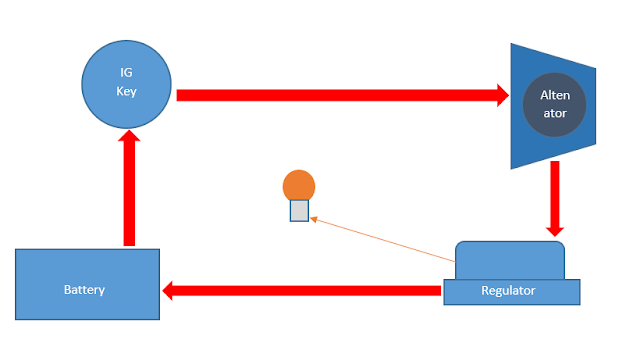7 Parts Of Charging System and Their Functions
David Sigalingging
3 min read
The main component of the charging system is an altenator, this component is same as the AC generator that will turn the rotary energy into electrical energy using electromagnetic force.
Read also How Does An Altenator Work ?
However, to support the charging power need some additional components. There are at least about 6 additional components needed to get it work, then what are the components ? check the article below.
Car Charging System Components and Functions

In general, the components of the charging system are composed of altenators and regulators. However, the charging system needs to add some additional components so that the electricity generated can be supplied to the battery and to all electrical loads safely and precisely. The component, consisting of;
1. Battery
The function of the battery is as a storage of electrical energy. Like a warehouse, the battery will store all the electrical energy generated by the altenator and then this stored electricity is removed when necessary.
2. Fuse and Fuseble links
Fuse and fuseble links have different functions even though have the same shape. Fuseble link can be called as main fuse which is placed near the battery positive terminal. The function of this fuse is to protect the entire electrical system of the car from excessive currents. Generally the fuseble link has a capacity of up to more than 60 Ampere.
While the function of the fuse is as a safety of a series of specific electrical wiring, in conventional charging system there are two fuse with same capacity (its about 10-15 Ampere). A fuse is used as a voltage regulator fuse and another fuse is used to secure the CHG and Voltage relay.
3. CHG Lights
CHG lamp or commonly also called “charging warning light” is an indicator light to indicate the presence failure of charging system. When the ignition key ON then this light will light up normally, as well as when the engine life of this lamp should turn on, if it is dead then it could mean the charging system failure.
4. Ignition key
The ignition key works as a switch. The charging system will be activated automatically when the engine is running, but to generate a magnetic field on the rotor coil must be done by a switch.
Ignition switch is used as a switch to connect anddisconnect power (positive battery curents) from battery to rotor coil. When the ignition key is ON, then the electricity from the battery to the coil rotor will be connected. However, when the ignition key is turned OFF then the power supply will be cut off. So it is not possible the altenator generates electricity when the ignition key is OFF even the engine crankshaft is rotate.
5. Regulator
The function of the regulator is to regulate the voltage generated by the altenator. Why should it be there? because the voltage generated by the altenator depends the engine's RPM. This means that if the engine RPM is low, the altenator voltage is also low, but if the engine RPM is high then the altenator voltage is also high.

The regulator will be used to keep the voltage generated by the altenator not exceeding 14 volts even if the engine run in high RPM. This voltage setting aims to protect the electrical components of the vehicle to prevents over-voltage.
There are two types of regulators, namely type or conventional type and type of IC. The point type/conventional uses two coils to adjust the altenator's output voltage. While the IC Regulator uses an IC circuit (Integrated Circuit) to regulate the output voltage.
6. Altenator

The function of the altenator is to convert a partial engine's rotating energy into electricity. The altenator input comes from the engine pulley connected through a V belt, the rotation of the rotor will cause the intersection of the magnetic force line with the stator coil so that the electrons flow on the stator coil.
The electricity in the stator coil is not directly connected to the battery, but it must pass through the diode bridge to rectify the current. This is done because the current in the stator coil is AC (Alternate Curent).
7. Charging Wires
The function of charging wires are to connect every component of the charging system, there are at least two types of wires: standard wire and B + wire. The standard wire has a small diameter like the car's electrical wiring in general, the function of this wire is connecting each terminal on the entire charging system.
While the B + wire has a larger diameter than the standard wire and almost matches the stater wire. The function of this wire is to connect the terminal B altenator with Battery.










Berkomentar dengan bijak dan sesuai topik artikel.